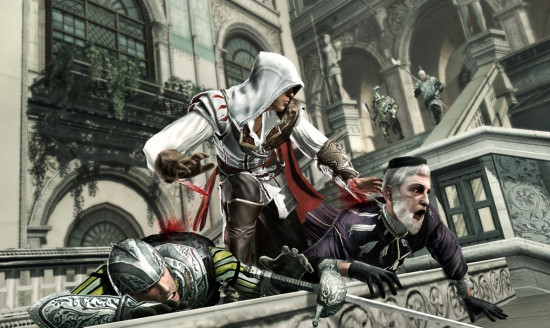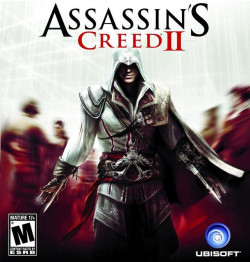
Assassin's Creed got a justifiably mixed response when it was released in 2007. I loved it for its free-running style in a giant open-world setting and its perspective on religious history, but I also loathed it because of the repetitive missions and the lack of combat AI. With the newly released sequel, the developers go a long way toward fulfilling their promise to address players' complaints about the original.
Assassin's Creed II takes place in 15th Century Italy (300 years after the first game), as you experience the life and trials of Ezio Auditore da Firenze, an Italian nobleman playboy -- fighting for honor during the day and romancing the ladies at night. After a conspiracy against his family takes the lives of his father and brothers, he discovers his father's double life as a member of the ancient order known as the Assassins. He begins to learn the ways of the Assassins while on the front lines of their battle against the Templars -- the group that murdered his father and wants to control the world.
The mission structure from the original Assassin's Creed required players to gather information in the same tedious ways each time -- eavesdropping, pickpocketing, or interrogating -- before finally assassinating the target. And there were only nine targets in the game.
 With the sequel, the repetition is a thing of the past, with almost every mission in a different style -- such as protecting hostages, raiding the tombs of previous Assassins, and battling with hired mercenaries at your side -- and a lot more focus on actual assassinations. It does a good job keeping you on your toes without being overwhelming. The game's story reaches well over the 20-hour mark, and even though toward the end it begins to feel like a bit of a grind, the epic finale makes it worthwhile.
With the sequel, the repetition is a thing of the past, with almost every mission in a different style -- such as protecting hostages, raiding the tombs of previous Assassins, and battling with hired mercenaries at your side -- and a lot more focus on actual assassinations. It does a good job keeping you on your toes without being overwhelming. The game's story reaches well over the 20-hour mark, and even though toward the end it begins to feel like a bit of a grind, the epic finale makes it worthwhile.
Ezio also has a family friend in Leonardo da Vinci, who is always willing to help with new inventions Ezio can use, such as his flying machine.
Art design sells the feel of 15th Century Italy. Landmarks such as Santa Maria del Fiore and cities such as Florence and Venice are all rendered in amazing detail, and after comparing the real ones to the game designs, the computer-generated environments are similar to what you'll find in Italy today.
The game's map system lacks information about which buildings are which -- making it a pain to navigate around the city when looking for specific areas -- but if you get lost, a real map of Venice can actually help you on your way. (It would have been nice to include a map with the game instead of making me search for it on the Internet, though.)
Notoriety is an upgraded feature in the sequel, making guards' pursuit of Ezio less ridiculous. In the first game, running and hiding from guards would dispel any notoriety you had generated. Now your crimes are being tracked. Keeping your actions low-key will make things more peaceful, while crimes such as robbery and murder will make you a wanted man. If you cross too many lines, you become a notorious criminal and have a much harder time blending in with the crowd. You can rip down wanted posters or bribe guards to reduce the heat, which is more difficult but more realistic than hiding in a haystack watching as your crimes are mysteriously pardoned.
Combat did not receive the same overhaul as the mission structure but has still been improved from the first game. Instead of being restricted to three weapons, Ezio can return to his safe house and switch between 22 different primary weapons, along with pistol and poison enhancements to the Assassins' trademark hidden weapon -- used for quick and stealthy kills. Beyond his own arsenal, Ezio can disarm his enemies and use their weapons. Taking a guard's spear and running him through with it is priceless, and often scares other guards away.
The character design unfortunately lacks the same touch as the environments. From a distance the characters look great, and with the gameplay primarily using the long-distance camera, it works for the most part. Once the view gets in close for cut scenes, though, the gameplay engine doesn't hold up as well, with a lot of rough pixels in the shadows and character's fingers becoming oddly square. It's a common problem in free-roaming games with the Grand Theft Auto style, but it's still inexcusable.
Although the first Assassin's Creed had its share of problems, I still enjoyed it and thought it would be the groundwork for an even better game. The changes and upgrades in the sequel definitely do a lot to move the series in the right direction. It still has a few issues to be addressed for the next chapter, but the improvements in Assassin's Creed II make it worth the ride.
Assassin's Creed II is now available on Xbox 360 and PlayStation 3 for $59.95. For this review, the author completed the game's story.
Luke Hamilton is a buyer, creative designer, and online coordinator for Video Games Etc. He can be reached at ssj_4luke@hotmail.com.








